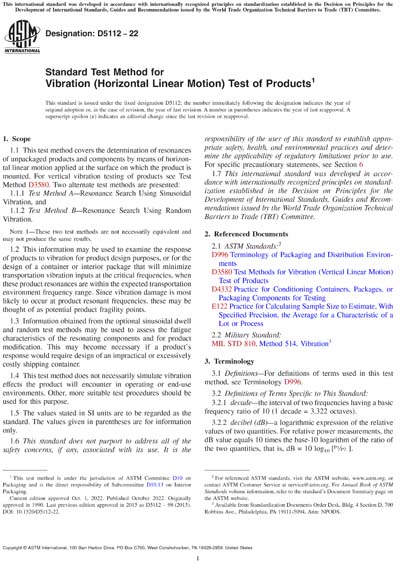Most recent
ASTM D5112-22
Standard Test Method for Vibration (Horizontal Linear Motion) Test of Products
1.1This test method covers the determination of resonances of unpackaged products and components by means of horizontal linear motion applied at the surface on which the product is mounted. For vertical vibration testing of products see Test Method D3580. Two alternate test methods are presented:
1.1.1Test Method A - Resonance Search Using Sinusoidal Vibration, and
1.1.2Test Method B - Resonance Search Using Random Vibration.
Note 1:These two test methods are not necessarily equivalent and may not produce the same results.
1.2This information may be used to examine the response of products to vibration for product design purposes, or for the design of a container or interior package that will minimize transportation vibration inputs at the critical frequencies, when these product resonances are within the expected transportation environment frequency range. Since vibration damage is most likely to occur at product resonant frequencies, these may be thought of as potential product fragility points.
1.3Information obtained from the optional sinusoidal dwell and random test methods may be used to assess the fatigue characteristics of the resonating components and for product modification. This may become necessary if a product's response would require design of an impractical or excessively costly shipping container.
1.4This test method does not necessarily simulate vibration effects the product will encounter in operating or end-use environments. Other, more suitable test procedures should be used for this purpose.
1.5The values stated in SI units are to be regarded as the standard. The values given in parentheses are for information only.
1.6This standard does not purport to address all of the safety concerns, if any, associated with its use. It is the responsibility of the user of this standard to establish appropriate safety, health, and environmental practices and determine the applicability of regulatory limitations prior to use. For specific precautionary statements, see Section 6
1.7This international standard was developed in accordance with internationally recognized principles on standardization established in the Decision on Principles for the Development of International Standards, Guides and Recommendations issued by the World Trade Organization Technical Barriers to Trade (TBT) Committee.
ASTM International [astm]

